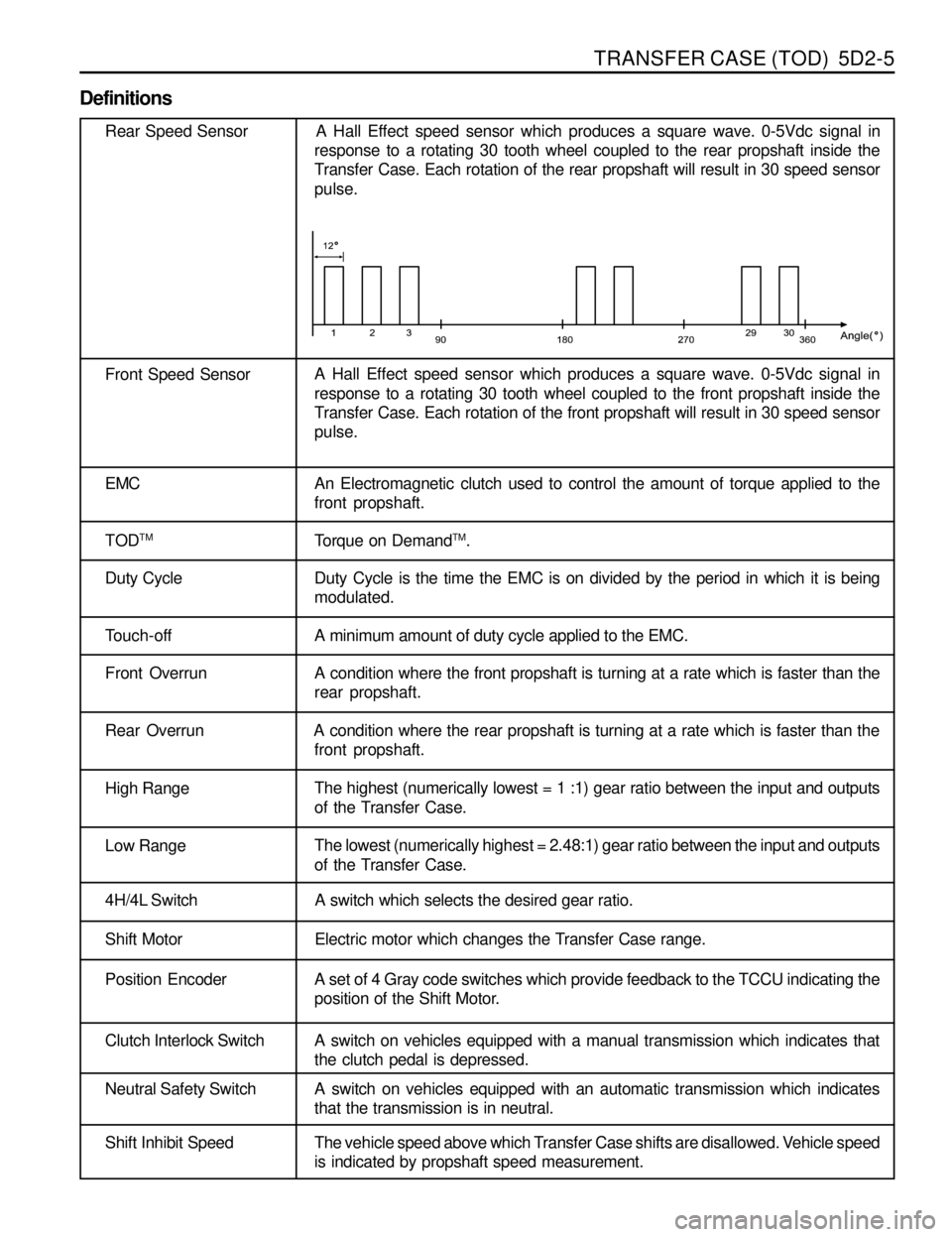1998 SSANGYONG MUSSO change time
[x] Cancel search: change timePage 998 of 1463

AUTOMATIC TRANSMISSION 5A-21
Downshift Type
RANGE ‘1’ (MANUAL ‘1’):
RANGE ‘2’ (MANUAL ‘2’):
RANGE ‘3’ (MANUAL ‘3’):
RANGE ‘D’ (DRIVE):
RANGE ‘N’ (NEUTRAL):
RANGE ‘R’ (REVERSE):
RANGE ‘P’ (PARK):Inhibited Above
First gear operation only with inhibited engagement as a function of vehicle
speed. Engine braking is applied with reduced throttle.
First and second gear operation with inhibited engagement of second gear, as
a function of vehicle speed. Engine braking is applied with reduced throttle.
First, second and third gear operation with an inhibited third gear engagement
at high vehicle speed. Refer to the vehicle owner’s manual.
Engine braking is applied with reduced throttle.
First, second, third and fourth gear operation. First to second (1-2), first to third
(1-3), second to third (2-3), second to fourth (2-4), third to fourth (3-4), fourth
to third (4-3), fourth to second (4-2), third to second (3-2), third to first (3-1)
and second to first (2-1), shifts are all available as a function of vehicle speed,
throttle position and the time rate of change of the throttle position (forced
downshift). Lockup clutch may be enabled in 3rd and 4th gears depending on
vehicle type. Refer to the owner’s manual.
Rear band applied only, with inhibited engagement as a function of vehicle
speed, engine speed and throttle position. The inhibitor switch allows the en-
gine to start.
Reverse gear operation, with inhibitor engagement as a function of vehicle
speed, engine speed and throttle position. The inhibitor switch enables reverse
lamp operation.
Rear band applied only, with inhibited engagement as a function of vehicle
speed, engine speed and throttle position. The transmission output shaft is
locked. The inhibitor switch allows the engine to start.
Table 2.1 - Gear Selections
DRIVING MODE SELECTOR
The driving mode selector consists of a mode selection switch and indicator light. The driving mode selector is
located on the centre console. See figure 2,1.
The schedules available to be selected vary with vehicle types. Typically the driver should have the option to select
between ‘NORMAL’ , ‘POWER’ or ‘WINTER’ modes.
When ‘NORMAL’ mode is selected upshifts will occur to maximise fuel economy and the indicator lights remain
extinguished. When ‘POWER’ mode is selected upshifts will occur to give maximum performance and the ‘POWER’
mode indicator light is switched on. When ‘WINTER’ mode is selected, starting at second gear is facilitated, the
‘WINTER’ mode indicator light is switched on and the ‘POWER’ mode indicator light is switched off.
Refer to the vehicle owner’s manual for specific modes for each vehicle type.
Page 1001 of 1463

5A-24 AUTOMATIC TRANSMISSION
Transmission Control Unit(TCU)
The TCU is an in-vehicle micro-processor based transmission management system. It is usually mounted in the
vehicle cabin, under the instrument panel, under the seat, behind the side kick panels or under the floor in the
footwell on the passenger side. Different control units are supplied for different vehicle applications.
The TCU contains:
lProcessing logic circuits which include a central microcontroller and a back-up memory system.
lInput circuits.
lOutput circuits which control external devices such as the variable pressure solenoid (VPS), on/off solenoid
drivers, a diagnostics output and the driving mode indicator light.
The various items which make up the TCU are discussed below.
Processing Logic
Shift schedule and calibration information is stored in an erasable programmable read only memory (EEPROM).
Throttle input calibration constants and the diagnostics information are stored in electrically erasable programmable
read only memory (EEPROM) that retains the memory even when power to the TCU is disconnected.
In operation the software continuously monitors the input values and uses these, via the shift schedule, to determine
the required gear state, At the same time it monitors, via the solenoid outputs, the current gear state. Whenever the
input conditions change such that the required gear state is different to the current gear state, the TCU initiates a
gear shift to bring the two states back into line.
Once the TCU has determined the type of gear shift required the software accesses the shift logic, estimates the
engine torque output, adjusts the variable pressure solenoid ramp pressure then executes the shift.
The TCU continuously monitors every input and output circuit for short or open circuits and operating range. When
a failure or abnormal operation is detected the TCU records the condition code in the diagnostics memory and
implements a limp mode, The actual limp mode used depends upon the failure detected with the object to maintain
maximum driveability without damaging the transmission. In general input failures are handled by providing a default
value. Output failures, which are capable of damaging the transmission, result in full limp mode giving only third or
fourth gear and reverse. For further details of limp modes and memory retention refer to the Diagnostic Section.
The TCU is designed to operate at ambient temperatures between -40 and 85°C . It is also protected against
electrical noise and voltage spikes, however all the usual precautions should be observed, for example when arc
welding or jump starting.
TCU Inputs
To function correctly, the TCU requires engine speed, road speed, transmission sump temperature, throttle position
and gear position inputs to determine the variable pressure solenoid current ramp and on/off solenoid states. This
ensures the correct gear selection and shift feel for all driving conditions.
The inputs required by the TCU are as follows:
lEngine Speed
The engine speed signal is derived from the tachometer signal line, a dedicated sensor or a Controlled Area
Network (CAN).
lRoad Speed
4WD (Diesel) - The shaft speed signal is derived from the speedo sensor located on the transfer case. This signal
is transmitted directly to the TCU.
4WD (Gasoline) - The speedo sensor sends the shaft speed signal to the engine control module (ECM). The
information is then transferred to the TCU via the CAN.
lTransmission Sump Temperature
The transmission sump temperature sensor is a thermistor located in the solenoid wiring loom within the transmission.
This sensor is a typical NTC resistor with low temperatures producing a high resistance and high temperatures
Page 1014 of 1463

AUTOMATIC TRANSMISSION 5A-37
Figure 3.16 - Clutch Apply Regulator Valve
Clutch Apply Regulator Valve
The clutch apply regulator valve (refer figure 3.16) is a fixed ratio valve. This valve provides a regulated pressure to
the C1 clutch and controls the rate of change of state of the clutch to give the desired shift quality.
This ratio is 2.25 : 1.
Third gear oil supplied to the valve is regulated to provide an output pressure (CAF) of 2.25 times the S5 signal
pressure when S3 is On. When S3 is Off the output pressure is 2.25 times the line 500 pressure.
Band Apply regulator Valve
The band apply regulator valve (refer figure 3.17) is a fixed ratio valve. It provides a regulated pressure to the front
servo, and controls the rate of change of state of the front band (B1) to give the desired shift quality.
This ratio is 1.4 : 1.
Second gear oil supplied to the valve is regulated to provide an output pressure (BAF) of 1.4 times the S5 signal
pressure when S4 is On. When S4 is Off the output pressure is 1.4 times the line 500 pressure.
Figure 3.17 - Band Apply Regulator Valve
Page 1042 of 1463

AUTOMATIC TRANSMISSION 5A-65
If the gear lever is incorrectly adjusted, the transmission may shift gears on bumpy road surfaces.
6 Transmission Oil Temperature Sensing Fault
lAll shifts will be firm until the transmission has warmed up, because a high transmission oil temperature is
assumed.
If a fault is undetected, the temperature is likely to be evaluated as being lower than actual, resulting in softer shifts
with ‘end bump’ (very firm feel at the end of the shift).
7 Mode Setting Fault
lAll shifts will occur as if the mode is set to ‘NORMAL’.
lThe mode indicator will always be off indicating that ‘NORMAL’ mode is selected.
lThe mode indicator will not respond to changes in switch setting.
If a fault is undetected, the mode as indicated by the mode indicator is not likely to respond to the mode switch.
8 Battery Voltage Sensing Fault
If the battery voltage is low then shifts to first gear are inhibited.9 the battery voltage is high (>16.5V) then the
transmission goes into limp home (LHM) mode.
If a fault is undetected, the transmission is likely to incorrectly evaluate an ON/OFF solenoid fault resulting in limp
home mode (LHM) operation.
9 ON/OFF Solenoid Fault (Solenoids 1,2,3 and 4)
The transmission adopts its limp home mode (LHM) operation, described above. However, if solenoid 1 is faulty then
the fourth gear LHM strategy will be adopted independent of vehicle speed.
If a fault is undetected, the operation of the transmission is dependent on which solenoid is actually faulty. The
characteristics for different solenoid fault conditions are listed in table 6.1.2.
10 ON/OFF Solenoid Fault (Solenoids 6,7)
If solenoid 6 is found faulty it is always disabled resulting in high line pressure being applied continuously.
If solenoid 7 is found faulty it is disabled resulting in the transmission being locked always.
The transmission does not go into LHM.
11 Variable Pressure Solenoid Fault
The transmission adopts its LHM operation.
If a fault is undetected, the transmission shift feel is likely to be poor for all shifts.
12 Software Fault
The transmission adopts the third gear LHM strategy of operation, independent of vehicle speed. The operation of
the TCU under this condition is difficult to predict. Its operation may be erratic.
If a fault is undetected, the operation of the TCU is likely to be erratic.
13 Power Supply Fault
The transmission adopts the third gear LHM strategy of operation, independent of vehicle speed. If there is an
intermittent power supply connection, the TCU will power-up in fourth gear and then shift to the appropriate gear to
satisfy the conditions present. The power supply is not monitored for fault evaluation.
All faults except for solenoid faults can be recovered without having to turn the TCU off and back on. However, in
general the recovery requires that no faults are present for a period of time (approx. 3 or 30 seconds). Recovery from
a fault will not clear the fault from the keep alive memory
14 Transmission Sump Temperature Exceeding 135°C
lThe converter lockup clutch will be applied at lower speeds, causing a shudder through the vehicle.
lThe mode indicator will flash in some vehicles.
These faults can be due to the transmission oil overheating or due to an incorrect signal received from the temperature
sensor.
Page 1045 of 1463

5A-68 AUTOMATIC TRANSMISSION
Description / Cause
The signal from the mode switch is unreliable.
This fault is caused by too many changes in the mode input signal
over a period of time. Typical causes would be an intermittent connec
tion in the switch or wiring or an intermittent short to ground in the
wiring.
The data link between the TCU and the engine management module
is found to be unreliable because the checksum, or the data received,
did not match the correct checksum.
This could be caused by an open circuit, short circuit to ground or a
loose connection in the link wire itself.
Each solenoid in turn is switched off if it was energised, or switched on
if it was not energised by a very small 100 ms pulse. This pulse is too
short for the solenoid to react so transmission operation is not af
fected.
The solenoid feedback voltage is measured before the 100 ms pulse
and again during the pulse. If the difference is outside the acceptable
limits the relevant fault messages are set.
Typical causes would be an open circuit in the wiring to or within the
solenoid, or a short circuit to ground in the wiring to, from or within the
solenoid in question.
If several of these fault codes are presents check the wiring or
connectors that are common to the selected solenoids, especially the
earth connections.
The state of the solenoid feedback voltage is outside acceptable
limits but the faulty solenoid could not be isolated.
The current to solenoid 5 was outside acceptable limits.
This fault results from a mismatch between the current set point for
solenoid 5 and the current measured by the feedback within the TCU.
Typical causes would be an open circuit or short circuit to ground in
the wiring to, from or within the solenoid. It is also possible that there
has been a fault in the solenoid output circuit. If this is the case
however, the fault should be continually present.
The closed throttle position has not been learnt. This fault
may be caused by the transmission not having reached normal
operating temperature or the engine idle speed being incorrect.
The TCU will learn the closed throttle position automatically
when the transmission is brought to normal operating
temperature and the engine is allowed to idle in Drive with the
‘base idle’ correctly set and the air conditioner (if fitted)
switched off. Condition
Mode Switch Input Fault
(Power/Economy Mode)
Data Output Link Fault
On/off Solenoid Fault
(Solenoid 1,2,3,4,6,7)
Solenoid 5 Fault
(Variable Pressure
Solenoid)
Throttle Not LearntSolenoid
9
10
11
12
13
Page 1180 of 1463

5D1-10 TRANSFER CASE (PART TIME 4408)
MAINTENANCE AND REPAIR
ON-VEHICLE SERVICE
MAINTENANCE OF TRANSFER CASE
LUBRICANT
Oil Level Check
lClean the oil level plug and surrounding area.
lRemove the oil level plug and check whether oil is drip
out or not.
lTighten the oil level plug.
Oil Change
lClean the oil level plug and surrounding area
lPlace a suitable container under the transfer case.
lRemove the oil and tighten the drain plug.
lFill the oil through the oil level plug until oil begins to
drip out.
lTighten the oil level plug.
Cautions for oil level check and plugs tightening
lDo not use an impact wrench to remove or tighten the
oil level plug or drain plug since this will damage the
threads in the transfer case.
Tightening Torque 20 - 30 Nm
Page 1212 of 1463

TRANSFER CASE (TOD) 5D2-5
Definitions
Rear Speed Sensor A Hall Effect speed sensor which produces a square wave. 0-5Vdc signal in
response to a rotating 30 tooth wheel coupled to the rear propshaft inside the
Transfer Case. Each rotation of the rear propshaft will result in 30 speed sensor
pulse.
Front Speed SensorA Hall Effect speed sensor which produces a square wave. 0-5Vdc signal in
response to a rotating 30 tooth wheel coupled to the front propshaft inside the
Transfer Case. Each rotation of the front propshaft will result in 30 speed sensor
pulse.
EMC An Electromagnetic clutch used to control the amount of torque applied to the
front propshaft.
TOD
TMTorque on DemandTM.
Duty Cycle Duty Cycle is the time the EMC is on divided by the period in which it is being
modulated.
Touch-off A minimum amount of duty cycle applied to the EMC.
Front OverrunA condition where the front propshaft is turning at a rate which is faster than the
rear propshaft.
Rear Overrun A condition where the rear propshaft is turning at a rate which is faster than the
front propshaft.
High RangeThe highest (numerically lowest = 1 :1) gear ratio between the input and outputs
of the Transfer Case.
Low RangeThe lowest (numerically highest = 2.48:1) gear ratio between the input and outputs
of the Transfer Case.
4H/4L Switch A switch which selects the desired gear ratio.
Shift Motor Electric motor which changes the Transfer Case range.
Position Encoder A set of 4 Gray code switches which provide feedback to the TCCU indicating the
position of the Shift Motor.
Clutch Interlock Switch A switch on vehicles equipped with a manual transmission which indicates that
the clutch pedal is depressed.
Neutral Safety Switch A switch on vehicles equipped with an automatic transmission which indicates
that the transmission is in neutral.
Shift Inhibit Speed The vehicle speed above which Transfer Case shifts are disallowed. Vehicle speed
is indicated by propshaft speed measurement.
Page 1236 of 1463

TRANSFER CASE (TOD) 5D2-29
Shift motor malfunction : Fault code ® 1741,
1742, 1743
lPhenomenon
1. When change the 4H/4L switch from 4H to 4L, ‘4L’
indicator lamp turn off after blinking for a time and then
‘4WD CHECK’ indicator lamp turn on.
2. Fault codes display by diagnosis of SCAN-100 : 1741,
1742, 1743
3. The shifting operation is not occurred when 4H / 4L switch,
is operating.
lCause
Defect in shift motor, improper voltage provided, incorrect
connection in connector, short of wiring.
11-14 V
(Battery voltage)
Ye s
No E1
11-14 V
(Battery voltage)
Ye s
No
Ye s
No
E2
Ye s
No Test Stage / Contents
Result
Stage Test Contents and ProcedureSpecified Value
/Yes/NoCountermeasure
Check the input voltage of shift motor.
1. Turn the ignition switch to “ON” position.
2. Measure the Hi/Low voltage of motor which is located
between No.1/No.14 and No.2/No.15 connector of TOD
control unit with digital Multi-tester or which is located
between No.G connector and body after detaching T/C
motor connector.
- The specified value (When operates 4H/4L switch)
- Measured value is within specified range ?
3. Measure the Hi/Low voltage of motor which is located
between No.2/No.5 and No.1/No.14 connector or which
is located No.B connector and body after detaching T/C
motor connector
- The specified value (When operates 4H/4L switch)
- Measured value is within specified range ?
Check the fault condition of the relevant connector.
1. Check the installation condition of TOD control unit 30pin
connector and T/C shift motor connector.
- Is it installed properly ?
2. If the connector installation is improper, install properly
and then perform follows :
a. Delete the fault code of control unit by scan scope
b. Turn off the ignition switch
c. Turn on the ignition switch
d. Re-diagnosis of system
It displays one or more fault code among 1741 to 1743.Perform E1-3 stage
Perform E2 stage
Perform E4 stage
Perform E2 stage
Perform E3 stage
Perform E2-2 stage
Perform E3 stage
Normal system